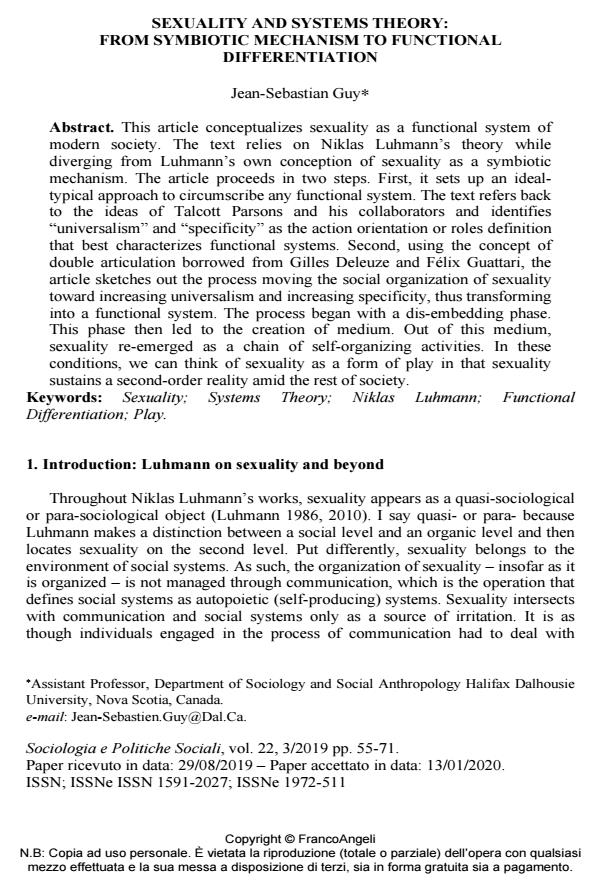Sexuality and systems theory: from symbiotic mechanism to functional differentiation
Titolo Rivista SOCIOLOGIA E POLITICHE SOCIALI
Autori/Curatori Jean-Sebastian Guy
Anno di pubblicazione 2020 Fascicolo 2019/3 Lingua Italiano
Numero pagine 17 P. 55-71 Dimensione file 232 KB
DOI 10.3280/SP2019-003003
Il DOI è il codice a barre della proprietà intellettuale: per saperne di più
clicca qui
Qui sotto puoi vedere in anteprima la prima pagina di questo articolo.
Se questo articolo ti interessa, lo puoi acquistare (e scaricare in formato pdf) seguendo le facili indicazioni per acquistare il download credit. Acquista Download Credits per scaricare questo Articolo in formato PDF

FrancoAngeli è membro della Publishers International Linking Association, Inc (PILA)associazione indipendente e non profit per facilitare (attraverso i servizi tecnologici implementati da CrossRef.org) l’accesso degli studiosi ai contenuti digitali nelle pubblicazioni professionali e scientifiche
This article conceptualizes sexuality as a functional system of modern society. The text relies on Niklas Luhmann’s theory while diverging from Luhmann’s own conception of sexuality as a symbiotic mechanism. The article proceeds in two steps. First, it sets up an ideal-typical approach to circumscribe any functional system. The text refers back to the ideas of Talcott Parsons and his collaborators and identifies "universalism" and "specificity" as the action orientation or roles definition that best characterizes functional systems. Second, using the concept of double articulation borrowed from Gilles Deleuze and Félix Guattari, the article sketches out the process moving the social organization of sexuality toward increasing universalism and increasing specificity, thus transforming into a functional system. The process began with a dis-embedding phase. This phase then led to the creation of medium. Out of this medium, sexuality re-emerged as a chain of self-organizing activities. In these conditions, we can think of sexuality as a form of play in that sexuality sustains a second-order reality amid the rest of society.;
Keywords:Sexuality; Systems Theory; Niklas Luhmann; Functional Differentiation; Play.
- Bateson, G. 1972. Steps Toward an Ecology of Mind. Chicago: University of Chicago Press.
- Deleuze, G. and Guattari, F. (1987). A Thousand Plateaus. Minneapolis: University of Minnesota Press.
- Giddens, A. 1990. The Consequences of Modernity. Cambridge: Polity.
- Goffman, E. 1974. Frame Analysis. New York: Harper & Row.
- Guy, Jean-Sébastien 2018, “Niklas Luhmann before relational sociology: the
- cybernetics roots of systems theory” in Systems Research and Behavioral Science, vol: 35.
- — (2019), “Problems and differentiation: a Deleuze-Luhmann encounter” in Cybernetics and Human Knowing, vol: 26.
- — (forthcoming). La sexualité comme système social. In Piazzesi, C., Blais, M. and Lavigne, J. (eds.) (forthcoming), Sociologie de l’intimité. Montréal: Presses de l’Université de Montréal.
- Hardy, S. 2000. Feminist Iconoclasm and the Problem of Eroticism. Sexualities, vol: 3. DOI: 10.1177/13634600000300100
- Heider, F. 2017. Chose et medium. Paris: VRIN.
- Jackson, S. and Scott, S. (2010). Theorizing Sexuality. Maidenhead: Open University Press.
- Kalberg, S. 1994. Max Weber’s Comparative-Historical Sociology. Chicago: University of Chicago Press.
- Luhmann, N. 1982. The Differentiation of Society. Chicago: University of Chicago Press.
- — 1986. Love as Passion, Stanford, Stanford University Press.
- — 1989. Ecological Communication. Chicago: University of Chicago Press.
- — 2000a. Art as a Social System. Stanford: Stanford University Press.
- — 2000b. The Reality of Mass Media. Stanford: Stanford University Press.
- — 2010. Love. A Sketch. Cambridge: Polity.
- — 2012. Theory of society, volume one. Stanford: Stanford University Press.
- — 2013. Theory of society, volume two. Stanford: Stanford University Press.
- — 2017. Trust and Power. Cambridge: Polity.
- Parsons, T., Bales T. F. and Shils E. A. 1953. Working Papers in the Theory of Action. New York: Free Press.
- Parsons, T. and Shils E. A. (eds.). 1967. Toward a General Theory of Action. Cambridge: Harvard University Press.
- Parsons, T., Shils E. A. and Olds, J. 1967. Values, Motives, and Systems of Action. In Parsons, T. and Shils, E. (eds.) 1967, Toward a General Theory of Action. Cambridge: Harvard University Press.
- Spencer-Brown, G. 1972. Laws of Form. New York: Julian Press.
- Roth S and Schutz, A. 2015. Ten Systems: Toward a Canon of Function Systems. Cybernetics and Human Knowing, vol: 22.
- Simondon, G. 1964. L’individu et sa genèse physico-biologique. Paris: Presses Universitaires de France.
- Watzlawick, P. 1976. How Real Is Real? New York: Random House.
- Weber, M. 1978. Economy and society (2 volumes). Berkeley: University of California Press.
Jean-Sebastian Guy, Sexuality and systems theory: from symbiotic mechanism to functional differentiation in "SOCIOLOGIA E POLITICHE SOCIALI" 3/2019, pp 55-71, DOI: 10.3280/SP2019-003003